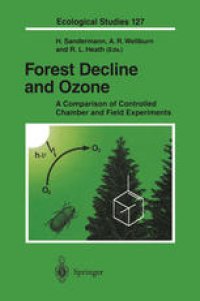
Ebook: Forest Decline and Ozone: A Comparison of Controlled Chamber and Field Experiments
- Tags: Ecology, Agriculture, Forestry, Atmospheric Protection/Air Quality Control/Air Pollution
- Series: Ecological Studies 127
- Year: 1997
- Publisher: Springer-Verlag Berlin Heidelberg
- Edition: 1
- Language: English
- pdf
The idea for this book arose in 1993, after the Free State of Bavaria through its Bayrisches Staatsministerium rur Landesentwicklung und Umweltfragen (Bavarian Ministry of Regional Development and the Environment) decided to discontinue both the Bavarian project management (PBWU) for forest decline research and the multidisciplinary field research on the Wank Mountain in the Alps near Garmisch. Forest decline through the action of ozone and other photooxidants was a main topic of the supported re search in the Alps and will be a topic of new investigations in the Bavarian Forest. Many interesting results were obtained, but the researchers involved have not had sufficient time to allow reliable conclusions to be drawn. It was therefore decided to ask inter national experts for contributions in order to summarize the best available evidence of a possible link between ozone and forest decline - a topic which has been studied in the USA since the late 1950s and in Europe since the early 1980s. The original idea of Waldsterben as an irreversible large-scale dieback of forests in Germany was soon recognized to be wrong (Forschungsbeirat 1989). However, the new criteria used for the official German and European damage inventories (loss or yel lowing of needles or leaves, tree morphology) indicate that per sistently high percentages of damaged spruce and pine remain, and there is an increasing percentage of damaged beech and oak, with a high proportion of biotic disease (Forschungsbeirat 1989; UN-ECE 1995).
The book explores the relationship between forest decline and ozone. It comprises a broad range of methods concerning field ecology, model ecosystem research, and basic physiological and biochemical research. Prominent features are the use of ozone dose rather than concentration values only, and the illustration of ozone effects in numerous exciting color photographs. The presented results are essential for designing new field and laboratory experiments.
The book is a must for anyone involved in air-pollution research!
The book explores the relationship between forest decline and ozone. It comprises a broad range of methods concerning field ecology, model ecosystem research, and basic physiological and biochemical research. Prominent features are the use of ozone dose rather than concentration values only, and the illustration of ozone effects in numerous exciting color photographs. The presented results are essential for designing new field and laboratory experiments.
The book is a must for anyone involved in air-pollution research!
Content:
Front Matter....Pages I-XXI
Ozone Formation, Destruction and Exposure in Europe and the United States....Pages 1-38
Ozone and Its Known and Potential Effects on Forests in Western United States....Pages 39-67
Ozone and Its Known and Potential Effects on Forests in Eastern United States....Pages 69-93
Ozone and the Forests in Austria and Switzerland....Pages 95-134
Role of Ozone in Forest Decline on Wank Mountain (Alps)....Pages 135-162
Ozone Responses of Trees: Results from Controlled Chamber Exposures at the GSF Phytotron....Pages 163-200
Controlled O3 Exposures and Field Observations of O3 Effects in the UK....Pages 201-247
Controlled Ozone Exposures and Field Observations in Fennoscandia....Pages 249-276
Methods for Controlled and Field Ozone Exposures of Forest Tree Species in North America....Pages 277-315
Physiological Processes and Plant Responses to Ozone Exposure....Pages 317-368
Forest Decline and Ozone: Synopsis....Pages 369-377
Back Matter....Pages 379-400
The book explores the relationship between forest decline and ozone. It comprises a broad range of methods concerning field ecology, model ecosystem research, and basic physiological and biochemical research. Prominent features are the use of ozone dose rather than concentration values only, and the illustration of ozone effects in numerous exciting color photographs. The presented results are essential for designing new field and laboratory experiments.
The book is a must for anyone involved in air-pollution research!
Content:
Front Matter....Pages I-XXI
Ozone Formation, Destruction and Exposure in Europe and the United States....Pages 1-38
Ozone and Its Known and Potential Effects on Forests in Western United States....Pages 39-67
Ozone and Its Known and Potential Effects on Forests in Eastern United States....Pages 69-93
Ozone and the Forests in Austria and Switzerland....Pages 95-134
Role of Ozone in Forest Decline on Wank Mountain (Alps)....Pages 135-162
Ozone Responses of Trees: Results from Controlled Chamber Exposures at the GSF Phytotron....Pages 163-200
Controlled O3 Exposures and Field Observations of O3 Effects in the UK....Pages 201-247
Controlled Ozone Exposures and Field Observations in Fennoscandia....Pages 249-276
Methods for Controlled and Field Ozone Exposures of Forest Tree Species in North America....Pages 277-315
Physiological Processes and Plant Responses to Ozone Exposure....Pages 317-368
Forest Decline and Ozone: Synopsis....Pages 369-377
Back Matter....Pages 379-400
....